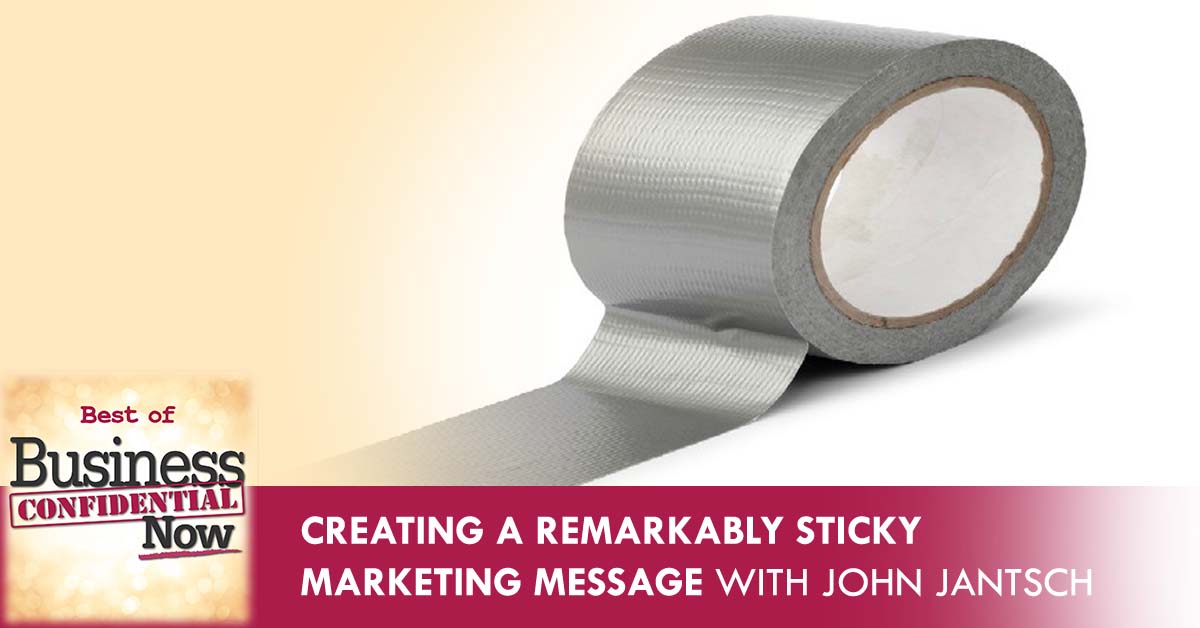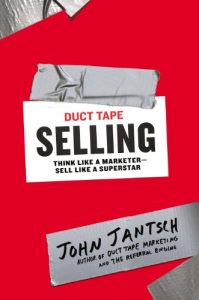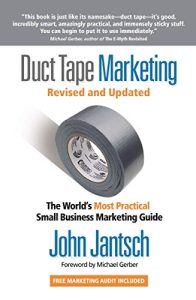
Photo Credit: © Can Stock Photo / Anterovium
Creating a memorable marketing message that sets your business apart from the competition can be serious challenge for many small and mid-size businesses. It’s easy to bounce from one “marketing idea of the week” to the next with little to show for your efforts except frustration.
Join host Hanna Hasl-Kelchner as she welcomes Duct Tape Marketing guru, John Jantsch, who has a better solution and a proven system to build demand for your products or services.
WHAT YOU’LL DISCOVER ABOUT A MARKETING MESSAGE:
- 3 keys to making your marketing message memorable.
- How we accidently trip ourselves up when creating a marketing message.
- Why some businesses are reluctant to embrace their best marketing message.
- Why a laser focused marketing message is more profitable than a one size fits all message.
- The fastest way to discover your ideal marketing message.
- Why sales and marketing shouldn’t be in separate silos.
- And MUCH more.
GUEST:
 John Jantsch has been called the World’s Most Practical Small Business Expert for consistently delivering real-world, proven small business marketing ideas and strategies.
John Jantsch has been called the World’s Most Practical Small Business Expert for consistently delivering real-world, proven small business marketing ideas and strategies.
He’s a marketing consultant, speaker and bestselling author of several books:
Duct Tape Marketing Revised and Updated: The World’s Most Practical Small Business Marketing Guide, Duct Tape Selling: Think Like a Marketer-Sell Like a Superstar, The Commitment Engine: Making Work Worth It, and The Referral Engine: Teaching Your Business to Market Itself. He’s also the creator of the Duct Tape Marketing System and Duct Tape Marketing Consulting Network that trains and licenses small business marketing consultants around the world.
In other words, he’s a marketer’s marketer.
John also frequently consults with small and mid-sized businesses. He helps them create marketing plans and organized marketing systems that smooth the way for steady growth.
His blog was chosen as a Forbes favorite for marketing and small business, and his podcast, a top ten marketing show on iTunes, was called a “must listen” by Fast Company magazine.
Huffington Post calls him one of the top 100 “Must Follow” on Twitter. Forbes named Duct Tape Marketing one of the 100 Best Websites for Entrepreneurs.
John is also the featured marketing contributor to American Express OPENForum and is a popular presenter of workshop and webinars for organizations such as Intuit, Verizon, HP, and Citrix.
His practical take on small business is also frequently cited in publications such as the Wall St. Journal, New York Times, and CNNMoney.
RELATED RESOURCES:
Contact John at Duct Tape Marketing, Duct Tape Marketing Consultant, or Duct Tape Marketing System, and connect with him on LinkedIn, Facebook.
—
Creating A Remarkably Sticky Marketing Message With John Jantsch
Creating a memorable marketing message sets your business apart from the competition, and it can be a serious challenge for many small and mid-sized companies. It’s so easy to bounce from one marketing idea of the week to the next with little to show for your efforts except for frustration, but take heart because our guest has a better solution and a proven system to build demand for your products or services. He is marketing guru, John Jantsch.
—
John Jantsch has been called the World’s Most Practical Small Business Expert for consistently delivering real-world, proven small business marketing ideas and strategies. He’s a marketing consultant, speaker, and best-selling author of several books, Duct Tape Marketing, Duct Tape Selling, The Commitment Engine, and The Referral Engine. He’s also the Creator of Duct Tape Marketing System and Duct Tape Marketing Consultant Network, which trains and licenses small business marketing consultants around the world. In other words, he’s a marketer’s marketer.
He also frequently consults with small and mid-sized businesses to help them create plans and organize marketing systems to smooth the way for steady growth. His blog was chosen as a Forbes favorite for marketing and small business, and his podcast, a top ten marketing show on iTunes, was called a must listen by Fast Company magazine. Huffington Post calls him one of the top 100 must-follow on Twitter, and Forbes named Duct Tape Marketing one of the 100 best websites for entrepreneurs.
If that were not enough, John is the featured marketing contributor to American Express OPEN Forum and is a popular presenter of workshops and webinars for organizations such as Intuit, Verizon, HP, and Citrix. His practical take on small business is also frequently cited in publications such as The Wall Street Journal, New York Times, and CNNMoney. If there was ever an expert to help you understand the key to developing a marketing system that can build your business, he’s it. I’m so thrilled to have him here with us. Welcome to the show, John.
I am happy to be here. I hope I can live up to that buildup.
I’m so confident you can. In your experience working with small and mid-sized companies, what is it about creating a memorable marketing message that trips people up?
A lot of it has to do with the fact that the most memorable marketing messages are typically small things that people do. A lot of times, it’s because they believe that’s how everybody treats customers or that’s how everybody acts. In some way, we often want to make ourselves feel like we’re bigger or more important, or more comprehensive than anyone. That gets in the way of refining something that helps that person that is looking for a difference identify that we’re uniquely suited to serve their personal needs.

Marketing Message: If you’re in startup mode, you need a hypothesis about what your market wants and how you can serve their challenges. And then get out there and start talking to everybody that fits that description.
Unfortunately, most people assume one accountant or plumber is like another. Unless we give them that reason to understand why we are the ones for them and only them, they will pretty much default to price. Anytime you’re talking about trying to come up with this unique message, you’re also telling some percentage of the market that, “We may not be for you.” That’s probably the biggest challenge because we’re fearful that anybody who has money might not call us.
That is the scary part. You’re turning away people that you probably would want to do business with. How do people narrow down to one little thing because they may be good at several little things?
I’ll tell you a little issue with that one point. A lot of the people you’re turning away, you are probably not ready to serve, or they don’t appreciate the value you bring or the way in which you’re able to get them a result is not the way they want to buy or operate. There are so many cases of businesses that have a great system worked out to get somebody a result, and that person’s too busy thinking about, “How can I get a cheaper price? How can I do this faster? How can I not have to go through the steps you need me to get a result? How can I just make it happen magically?” Those are the people you don’t want to do business with necessarily unless you’re in the how-can-I do-things-cheap-and-magically business.
Getting there to that narrow point is sometimes hard, but you have to because what happens is when you get to a place where your message starts resonating with people saying, “You’re talking about me. The way in which you do business sounds exactly like the way I like to do business,” people will start expecting to pay a premium to work with you as opposed to thinking about how they can get it cheaper.
In terms of how you get to that narrowly defined ideal client or ideal message, a lot of times, certainly what we do with anybody that’s got a number of clients or has been in business a number of times is their customers know what that unique point of difference is and far more often than the actual business owner does.
We heartily recommend that you have a routine of interviewing your customers, particularly if you’re trying to go on this hunt for your elusive core message. Many times, speaking with 8 or 10 of your best clients or your ideal clients and getting a sense of why they hired you, why they stay with you, and what you do that’s different is a great way to get that narrowly defined message.
The most memorable marketing messages are typically small things that people do. Share on XLet’s say somebody is in a startup mode. Microsoft back in the 1970s, whoever needed software back then? With Uber’s rideshare service in 2010, people weren’t familiar with it. How do they know they need it or think that’s the one they want?
The startup’s a little different because you’re in guess mode or assumption mode. A lot of times, companies that take off and explode overnight are companies that create something that people didn’t even know they needed. It’s very difficult to go out and do research on this product or service if people don’t even understand the problem they have that you might be solving.
Either way, it is still important to do some customer discovery. If you’re in startup mode, have a hypothesis about what you want the market to serve, who you want to serve, what their challenges are, and how you’re uniquely suited to serve those, and then get out there and start talking to everybody that you can that maybe fits into that description.
Don’t walk up to them with a completely done product or service and say, “Here it is. Would you buy it for this price?” Get those folks involved in telling you what it needs, how it needs to work, and what it needs to be priced at. In some ways, develop it with a market that has a need. That doesn’t mean that you blindly build Frankenstein because every single person you talk to has a feature request.
Having a sense of testing your hypothesis and discovering a market need is certainly the way that most startups evolve effectively. I would venture to say that you go and think about all of the startups that are household names. Probably, their original business plan, if they had one, did not look anything like what their business is now.

Marketing Message: There are three core elements when creating a message: you want to identify who your customer is, you want to identify the benefit of your product, and you want something that people can remember.
That’s very true. They’re probably surprised at what it has evolved into. How much trial and error should a business allow in testing its marketing message before they think it’s time to pull the plug and try something else?
That’s a tough question because my experience is most people get tired of their message before it’s even heard. They feel like they have to go a different direction every 3 or 4 months in order to stay fresh because maybe they’re tired of reading the same thing. My take is that while you need to evolve your message, have a unique point of view and stick with that, and use that strategy. All of your content needs to be the voice of that strategy and try to get to the point where anybody who is a customer of yours and maybe even some prospects of yours can think of one word that describes your business.
That’s the ultimate goal regardless of the size of your business, and yet, that goal takes tremendous consistency and repetitiveness year in and year out, saying many of the same things. You want to try to find and lockdown on that message that does resonate, but then, in many cases, you have to commit to years of reinforcing it.
To share a short story, many years ago, I worked for a company that did create that kind of a marketing message. They tripped across it in the late 1960s, but they stuck with it. Every couple of months or every quarter, their competitors would have this new campaign and a whole new look to their promotion. It was interesting to see the difference in the success of the different campaigns. The one that certainly stood the test of time was the one that could be boiled down to one word, which we eventually trademarked.
In this day and age when content has become such a foundational element of all marketing and communication, and the fact that we now can have such incredible analytics if we choose to plug them in and pay attention to them, we can know exactly what word people are responding to or what message seems to get shared the most. Paying attention to the analytics very early on is an extremely important element of how you lockdown on that one message, one type of campaign, or even that one channel that you’re in and decide that, “This is where we need to be and this is what we need to be saying.”
If you boiled it down, what are the key ingredients to making a marketing message memorable?
When your message relates to people, they will pay a premium to work with you, as opposed to asking for a cheaper price. Share on X
There are probably several ingredients that go into it. One of them is the idea of it’s something that catches people off guard. It upsets their normal path. It allows them to make a metaphor that’s meaningful. That’s all the creative art of it. The underpinning of that creative part has to be a benefit to that ideal client you’re at. They have to understand that your message is something that is clear, simple, and quick to communicate, “This difference is not just different. It’s meaningful. It has value to me. It’s remarkable.”
There are probably three core elements that we always talk about. Hopefully, you identify who your customer is so that somebody says, “You’re talking about me.” The second part is you identify a benefit that scratches an itch that hopefully they already know about. The third point, which is probably the icing on the cake, is it is something that people think is clever, memorable, and creative, so they want to talk about it.
Quite frankly, this didn’t come about with lots of focus groups. It’s from me just being in the trenches, but I often use a rule in the name of my business. Duct Tape Marketing is a pretty good representation of that memorable element. For many people, the metaphor of the duct tape is one that they think of fondly. It’s unique and stands out a little bit, but it also represents my target market. It’s simple, effective, and affordable. It doesn’t always have to be pretty but has to work. It does tick off a lot of those boxes.
I love the symbolism that you use. It’s wonderful. You use it in your books as well. How long did it take you to come up with that?
This was around 2000. I decided the internet thing was going to be a big deal. People are going to pay money and buy products and services. I’d developed my own small business marketing system because I was a little frustrated making it up every time with a client who said they needed this and then needed that, and I said, “I’ll get this. I’ll get that.”
I decided that what I needed to solve that frustration was to create a systematic approach where I could walk in and say, “Here’s what I’m going to do. Here’s what you’re going to do. Here are the results we hope we can get, and here’s what it costs. Do you want it or not?” With that systematic approach, ironically trying to solve my own greatest frustration, I immediately realized that I tapped one of the greater frustrations of most small business owners.

Marketing Message: Make a commitment to spend some time and have a conversation every month with your customers. You will learn things that you had no idea of about your product.
It’s hard to buy marketing services in a very comprehensive way because there’s everybody selling this piece and that part, so I took that idea of a systematic, almost productized approach and said, “I have to give it a name.” Originally, the name Duct Tape Marketing was what I applied to my marketing system. I quickly found that the name itself resonated, so I changed the name of my business to that. My first book was called Duct Tape Marketing. The blog, podcasts, and everything I do now have that name on it.
Many people offer different little pieces of the marketing pie. If you’re not a marketer, it’s hard to know like, “Maybe I should do this on social media.” If somebody is a small business looking to be a bigger business or in more of a startup mode, what are the three things they should nail down before getting more exotic or spreading their resources too thin?
The first we’ve been talking about all along here is strategy before tactics. A lot of times, what happens if somebody starts a business, they say, “I am XYZ company.” The first person that comes along and says, “You need SEO, and we can help you with that. You need social media. I’ve heard everybody talking about this Twitter thing. I’ll do that.” What happens is they end up doing the marketing idea of the week. That’s what I’d always called it.
If you have a firm strategy where you say at least initially or at some point, “Here is who makes an ideal client for our business. Here’s what their challenges are. Here’s how we’re uniquely suited to solve it and here’s how we’re going to communicate that,” that’s the basis of a firm foundation for marketing strategy. It becomes the filter for every decision you make about, “Should I be in this channel? Should I buy this? Should I advertise here?” That firm foundation is the first thing.
The second component then is to realize that content is not just another marketing tactic, but it needs to be the voice of your strategy. It is how you communicate to that ideal client that they should know you, might like you, should trust you, how they can try your products and services, how and why they might buy, how and why they might repeat buy, and how and why they might refer you. Those words that I used, know, like trust, try, buy, repeat, and refer, that’s the customer journey that you have to use your content to guide.
Content is not just another marketing tactic. It needs to be the voice of your strategy. Share on X
It’s that firm foundation of a strategy using content in the various forms as the voice of your strategy and then guiding your ideal customer on the journey that they want to take in order to become everything going from creating awareness about who you are and what you do to the point where they are a loyal and raving fan.
That certainly sets things up. That’s helpful because you’re right. People get them bombarded with these messages about SEO, the website, and this, that, and the other. It’s very easy to have to tail-wag the dog.
I’m not discounting any of those. I’m just suggesting that if you build that foundation first, then you can make intelligent decisions about how and why you might use one of those channels. When I started my business, we probably had 5 or 8 places where you could get the word out about your business. Sales, advertising, referrals, and PR were standard channels. Now, I routinely cite sixteen different channels that people can explore.
When you have that firm foundation, what you can do then is to focus on the 2 or 3 channels that make the most sense for your business based on your strategy and go deep into those and look at some of the other channels. Maybe it’s ways to support those channels that are working for you. Instead of trying to dip your toe in the water in every possible place, you go deep into 2 or 3 of the places where your ideal clients hang out and where you can have the greatest impact.
Besides writing the book Duct Tape Marketing, you also wrote Duct Tape Selling. Why the change in emphasis from marketing to selling?
I don’t see it as a change certainly as much as it is an extension. A lot of sales folks out there were starting to realize that nobody answered the phone anymore. When they get leads, they’re just supposed to chase down those leads or mind various lists to find the leads that they were becoming very ineffective.
The idea of Duct Tape Selling is to show sales folks, whether they’re the sales manager or that quota carrying salesperson, how to employ some of the newer marketing tactics like content and influencer outreach and even social media to get in front of more of the right prospects to stand out in a way that makes them different from everybody else that’s pounding on the door and trying to get access. That was the idea. It’s to say that marketing, sales, and service now have to function as one department and as an outcome or a results department and not in separate silos.
There’s more need to have them integrated than ever before.
I think so because the customer is in charge of the journey. It used to be that we would run an ad, and that person would respond to an ad. We then throw them over to sales, and sales would close and drive them through this linear path. How and why people decide to buy our products and services, about 75% of that journey is out of control.
Most people start their process of determining who they’re going to buy from and what they’re going to buy on their own, and by the time the company hears from them, they’ve probably either made a decision or they’re looking for a better price. The idea behind getting sales involved earlier in the journey and keeping them involved later in the journey is an acknowledgment of that. We as people are starting the process of going out and looking at how we get ourselves on that path or that journey, or how we help guide them on the journey that we know they’re taking.
These days, the customer is really in charge of the buyer's journey. Share on X
It’s interesting how the internet has changed that dynamic.
We don’t need a salesperson to show up and tell us what the new features are or even the new pricing because we now can go online. We can see review sites or places where people have pitted one software against another. We can go to our social networks and ask. That’s how we are starting the journey. We don’t want salespeople to show up and tell us why their product is better than somebody else’s.
We could also ask Siri. There are so many ways. One thing I enjoy about our conversation is the way you make this sound so practical, intuitive, and a natural part of business development or business planning. This is what it’s all about. This is why you have a business. This is the way you need to be doing it. I appreciate that.
It’s hard. I’m not suggesting it’s easy, but I am suggesting it’s not as complex as people try to make it.
That’s understood. People have heard the concepts, and they’re like, “That’s great. How do I apply it?” That’s where the rubber meets the road. The real challenge is, especially when it’s your business because you’re so close to it, it’s your baby. You know things that other people don’t that you may be taking for granted. I’m interested in this whole practical bent. How did you start your marketing journey? Were there things that influenced your career along the way that made you think this is what you want to do or your calling?
Sometimes, it’s hard to look back and identify those things because they just happen to you, and you don’t see them as milestones. Right out of college, I went to work for an ad agency business. I found out pretty quickly that I wanted to do my own thing. That working for somebody was the first milestone. It was the only job I’ve ever had before starting my company.
In terms of influence from a marketer standpoint, I usually point to one that a lot of people don’t think of in the marketing realm. The first book that I read that, to me, made marketing make sense was The Practice of Management by Peter Drucker, which was written in the ’50s. It was not directed at marketing people at all, but the way that he talks about the customers, the systems, and the processes in business, at that point was probably the first influence in terms of forming my point of view about marketing.
The biggest turning point when it comes to Duct Tape Marketing specifically was I read the book and then worked with Michael Gerber, the author of the E-Myth. Michael was one of the first people early on in the mid-’80S to talk about small businesses in a way that had never been talked about. It’s this idea of creating a franchise model and systems throughout the business.
That was the light bulb for me to say that a lot of businesses get that idea about creating systems for getting things done and doing inventory and paying the bills, but marketing is this one area of business that still seems to be this genie in a bottle or black magic as opposed to a system. That was the light bulb moment for me to create my own marketing system and start talking about marketing as a system as being the big idea of Duct Tape Marketing. Fortunately, when Duct Tape Marketing came out, Michael wrote the foreword for that book and put his stamp on the impact that he has had on my career.
We’re about out of time. Did you have any parting thoughts for our audience?
To wrap up some of the thoughts that we’ve talked about, the one thing that I urge anyone who’s reading this is to talk to your customers. Spend time with your customers, especially as they interact or use your products or services. You will gain so much insight. My experience tells me that you will learn things that you had no idea about, how your customers are using things, how they’re irritated by what you do, and how they talk about your business that you should be talking about your business. Make a commitment to spend some time every month in a very deep conversation with a number of your customers.
Thank you so much for your time, your insights, and for laying it all out. The audience should read this interview several times because there are so many good nuggets of wisdom here that are worth repeating. I appreciate you, I appreciate your work, and I appreciate your time. Thank you so much.
It’s my pleasure.
Important Links
- John Jantsch
- Duct Tape Marketing
- Duct Tape Selling
- The Commitment Engine
- The Referral Engine
- Duct Tape Marketing System
- Duct Tape Marketing Consultant Network
- The Practice of Management
- E-Myth
- https://www.Linkedin.com/in/DuctTapeMarketing/
- https://www.Facebook.com/DuctTapeMarketing
- What To Consider When Evaluating Your Start Up Business Ideas With Prof. Ted Zoller – previous episode
- If you liked this interview you might also like these Marketing episodes
Join, Rate and Review:
Rating and reviewing the show helps us grow our audience and allows us to bring you more of the rich information you need to succeed from our high powered guests. Leave a review at Lovethepodcast.com/BusinessConfidential
Joining the Business Confidential Now family is easy and lets you have instant access to the latest tactics, strategies and tips to make your business more successful.
Follow on your favorite podcast app here as well as on Twitter, Facebook, YouTube, and LinkedIn.
Download ♥ Follow ♥ Listen ♥ Learn ♥ Share ♥ Review ♥ Comment ♥ Enjoy
Ask Questions or Recommend a Topic/ Guest:
- Use our convenient Get in Touch form
- OR e-mail feedback(at)BusinessConfidentialRadio.com
Disclosure:
This post may contain links to products to products on Amazon.com with which I have an affiliate relationship. I may receive commissions or bonuses from your actions on such links, AT NO ADDITIONAL COST TO YOU


